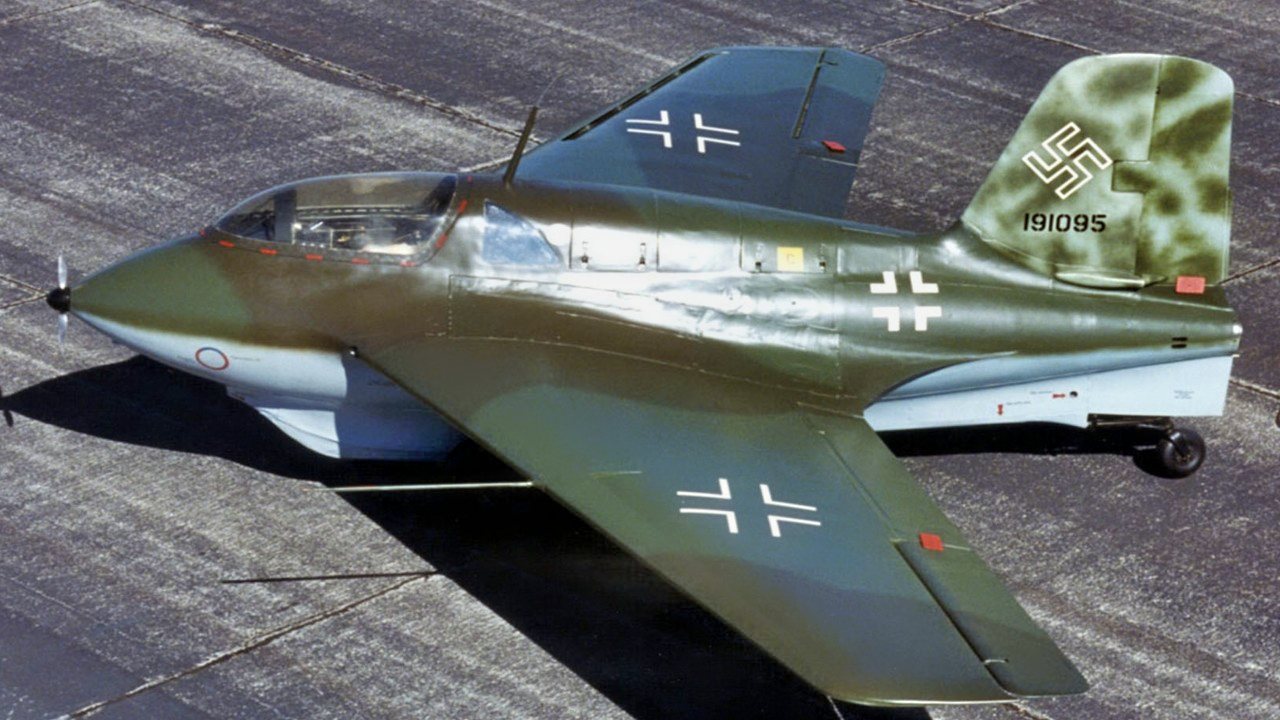
Me 163: Hitler’s Dangerous WWII Rocket Fighter
Me 163 Komet – A Short History – Rarely in the history of military aviation has an aircraft been so advanced that its rivals didn’t know how to counter it. Yet, such was the case with the Messerschmitt Me 163 Komet, a small and agile fighter that was nearly twice as fast as any other aircraft of the era.
Arguably the most ingenious and even radical of Germany’s combat aircraft to see service in the Second World War, the Me 163 achieved no small degree of success during the final nine months of the conflict. However, it reached operational units too late and in numbers too small to affect the ultimate outcome.
Origins of the Me 163 Komet
The Me 163 was based on the experimental DPS 194, which was designed in 1938 by Professor Alexander Lippisch, who had been a pioneer in rocket propulsion. After being transferred with his staff to Messerschmitt AG, Lippisch went to work on a new rocket engine.
However, he clashed with Professor Willy Messerschmitt on key attributes of the design, which resulted in developmental delays. It has been argued that if the two strong-willed personalities had been able to work together, the Komet would have certainly been developed sooner, and would have been in service much earlier.
Fortunately, for the Allies, the battles within Messerschmitt AG stalled the program.
The first two Me 163 prototypes were flown in the spring of 1941 as unpowered gliders, with Me 163V1 then transferred to the Peenemünde Army Research Center, where it received its 1,653 pounds st HWK R.II rocket motor. The first rocket-powered flight was made in August 1941, and in trials the fighter was able to exhibit speeds of more than 620 mph (1,000 km/h) – faster than any aircraft of the era. It was also 155 mph faster than the previous world speed record. Impressively, that record figure was only officially surpassed after the war by an American Douglass D-588-1 on August 20, 1947.
Ten unpowered Me 163As were then completed as conversion trainers, while the development continued.
Further Development
Subsequent research led to a modified wing with large fixed slots over the outer leading edge, which rendered the aircraft “spin proof” and address control issues that were discovered during the previous test flights.
However, a new issue arose with the Me 163B model, which was to cause endless problems and even result in catastrophic accidents. Due to the compact size of the rocket-powered plane, it was developed without landing gear. It was also a ton heavier than the original design weight. That necessitated the use of auxiliary booster rockets to get airborne, while the aircraft would take off from a wheeled dolly that jettisoned once in the air. To land, the pilot had to touch down directly on the fuselage keel-skid.
If the aircraft was not dead into the wind it could slew or veer around and possibly overturn, while any bump in the surface caused premature take-off or a bounce on landing. All of this was compounded by the highly volatile rocket fuel that could be accidentally ignited within the aircraft.
Further Development
Subsequent research led to a modified wing with large fixed slots over the outer leading edge, which rendered the aircraft “spin proof” and address control issues that were discovered during the previous test flights.
However, a new issue arose with the Me 163B model, which was to cause endless problems and even result in catastrophic accidents. Due to the compact size of the rocket-powered plane, it was developed without landing gear. It was also a ton heavier than the original design weight. That necessitated the use of auxiliary booster rockets to get airborne, while the aircraft would take off from a wheeled dolly that jettisoned once in the air. To land, the pilot had to touch down directly on the fuselage keel-skid.
If the aircraft was not dead into the wind it could slew or veer around and possibly overturn, while any bump in the surface caused premature take-off or a bounce on landing. All of this was compounded by the highly volatile rocket fuel that could be accidentally ignited within the aircraft.
Innovative and Deadly
Despite its shortfalls, the Me 163 Komet shocked the Allies when first used against the U.S. Eight Air Force’s B-17s over Germany in August 1944. The Komet’s spectacular speed, which provided an element of surprise, resulted in many early successes against the bomber formations – downing at least sixteen bombers.
However, the Komet has been seen as a failure in any operational sense. It required an experienced pilot, who was always put in harm’s way during takeoff and landing, and too much effort and resources were placed on the miracle weapon.
Fewer than 280 were produced during the war, and only ten have survived. Most of those were among the nearly fifty aircraft captured intact by the British Army at the end of the war, and used in subsequent testing. Three are currently in the United States, including one at the National Air and Space Museum’s Steve F. Udvar-Hazy Center near Washington, D.C.; one is in the collection of Paul Allen’s Flying Heritage Collection outside Seattle; and one is now fully restored and on display at the National Museum of the United States Air Force at Wright-Patterson Air Force Base (AFB), in Dayton Ohio.
About the Author
Peter Suciu is a Michigan-based writer who has contributed to more than four dozen magazines, newspapers and websites. He regularly writes about military hardware, and is the author of several books on military headgear including A Gallery of Military Headdress, which is available on Amazon.com. Peter is also a Contributing Writer for Forbes.


